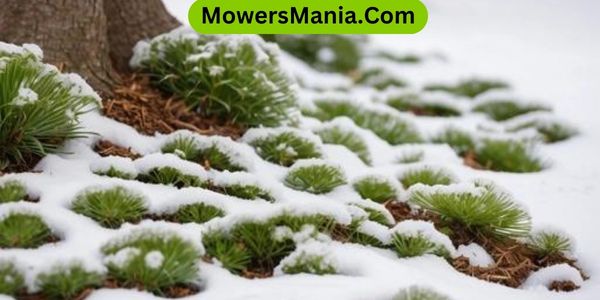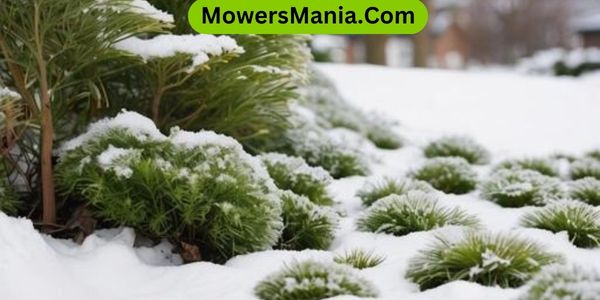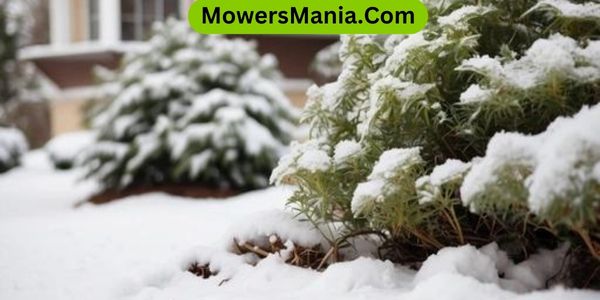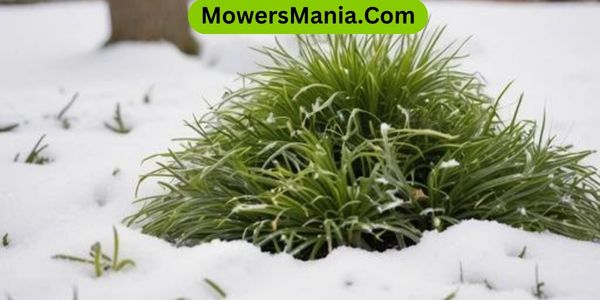Are your delicate plants at risk during the winter months? Don’t worry, we’ve got you covered! In this article, we’ll provide you with essential tips on how to protect your lawn during the winter season.

Learn about the benefits of mulching and discover the best techniques for proper mulching. We’ll also discuss effective methods for covering your delicate plants, ensuring they stay healthy and thriving throughout the cold weather.
Get ready to give your lawn the winter protection it deserves!
Importance of Winter Protection
Protecting your lawn and delicate plants during the winter is crucial for their survival. As the temperatures drop and frost sets in, your lawn and plants become vulnerable to the harsh winter conditions.
Without proper protection, they can suffer from frost damage, root rot, and even death. By taking the necessary steps to protect your lawn and delicate plants, you can ensure their survival and promote healthy growth come springtime.
One of the most effective ways to protect your lawn is by mulching. Mulch acts as an insulator, keeping the soil and roots warm and protected from freezing temperatures.
It also helps retain moisture in the soil, preventing it from drying out. Spread a layer of mulch around your lawn, focusing on areas where the grass is thin or exposed.
This will provide an extra layer of protection and help prevent damage caused by freezing and thawing cycles.
In addition to mulching, it’s important to cover delicate plants to shield them from the cold. Use frost blankets or burlap to cover plants such as roses, delicate flowers, and young shrubs.
This will help trap heat and protect them from freezing temperatures and frost damage. Be sure to secure the covers properly to prevent them from blowing away in strong winds.
Benefits of Mulching

To fully understand the benefits of mulching, it’s important to recognize how it actively contributes to the protection and health of your lawn during the winter months. Mulching offers several advantages that can help your lawn thrive even in harsh winter conditions.
- Insulation: Mulch acts as a protective layer that insulates the soil and plant roots. It helps regulate soil temperature, preventing extreme temperature fluctuations that can damage delicate plants. By providing insulation, mulch keeps the root system warm and protects it from freezing.
- Moisture Retention: Mulch helps retain moisture in the soil by reducing evaporation. During winter, when the ground is often frozen or dry, mulching helps keep the soil moist, which is crucial for the survival of plants. It also reduces the need for frequent watering, saving you time and effort.
- Weed Control: Mulch acts as a natural weed barrier, preventing weed growth and competition for nutrients and sunlight. By suppressing weed growth, mulch helps your lawn maintain its health and appearance throughout the winter season.
Types of Mulch to Use

When choosing the right mulch for your winter lawn protection, consider the different types available to cater to your specific needs.
Mulch not only helps insulate and protect your plants during the cold winter months, but it also helps retain moisture and suppress weed growth.
There are various types of mulch you can choose from, each with its own unique characteristics and benefits.
Here is a table that highlights some common types of mulch and their advantages:
| Type of Mulch | Advantages |
|---|---|
| Straw | Insulates well, improves soil structure, and allows for good airflow. |
| Wood Chips | Long-lasting, adds organic matter to the soil, and helps control soil erosion. |
| Pine Needles | Acidic, ideal for acid-loving plants, and provides good insulation. |
| Shredded Leaves | Inexpensive, easily available, and enriches the soil as it decomposes. |
| Cocoa Bean Hulls | Aromatic, adds nutrients to the soil, and deters pests. |
When selecting a mulch, consider the specific needs of your plants, the climate in your region, and the aesthetic appeal you desire.
Remember, the ultimate goal is to provide adequate protection and nourishment for your lawn and plants during the winter season. So, choose wisely and enjoy a healthy and thriving landscape come springtime.
Techniques for Proper Mulching
To properly mulch your winter lawn and protect delicate plants, follow these techniques.
- Start by preparing the area: Before applying mulch, make sure to remove any weeds, debris, or dead plants from the area. This will help create a clean and healthy environment for your lawn and plants.
- Apply mulch evenly: Spread a layer of mulch around your plants, making sure to cover the soil surface evenly. The mulch should be about 2-3 inches deep, but avoid piling it up against the stems or trunks of your plants. This can cause moisture buildup and lead to rot or disease.
- Leave space around the stems: When applying mulch, be careful not to cover the stems or trunks of your plants. Leave a small space around them to allow for air circulation and prevent moisture buildup. This will help keep your plants healthy and prevent the risk of rot or disease.
By following these techniques, you can ensure that your winter lawn and delicate plants are properly mulched and protected.
Mulching not only helps insulate the soil and protect against temperature fluctuations but also helps retain moisture and suppress weed growth.
Effective Covering Methods

Cover delicate plants with protective coverings to shield them from harsh winter conditions. When it comes to effective covering methods, there are a few options you can consider.
One popular method is using burlap or frost blankets. These materials provide a barrier against the cold and wind, while still allowing some airflow. Simply drape the fabric over the plants and secure it with stakes or rocks.
Another option is using plastic covers or cloches. These can be placed directly over individual plants or as a larger structure over a group of plants. Plastic covers help trap heat and create a mini greenhouse effect. Make sure to secure the edges of the plastic to prevent it from blowing away.
Additionally, you can use old sheets or blankets to cover plants. These can be easily wrapped around larger shrubs or small trees. Remember to anchor the fabric down to ensure it stays in place.
Whichever method you choose, make sure the coverings reach all the way to the ground to provide maximum protection. Take care not to damage the plants when applying the coverings, and remove them once the danger of frost has passed in spring.
Frequently Asked Questions [FAQs]
Are There Any Specific Plants That Require Extra Winter Protection?
Yes, there are specific plants that need extra winter protection. It’s important to cover delicate plants like roses, citrus trees, and tender perennials with mulch or protective coverings to shield them from frost and cold temperatures.
How Often Should I Water My Plants During the Winter Months?
During the winter months, you should water your plants less frequently than in the warmer seasons. It’s important to let the soil dry out between waterings to prevent overwatering and root rot.
Can I Use Any Type of Mulch for My Delicate Plants?
You can use any type of mulch for your delicate plants, but it’s best to choose one that provides good insulation and moisture retention. Consider using organic mulches like straw or shredded bark.
Are There Any Specific Techniques for Mulching Potted Plants?
Yes, there are specific techniques for mulching potted plants. You should use a layer of mulch about 2-3 inches thick, making sure to leave a small gap around the base of the plant to prevent rot.
What Are Some Alternative Methods to Cover Delicate Plants Besides Using Traditional Covers?
Instead of using traditional covers, you can try other methods to protect delicate plants in winter. One option is to use frost blankets or burlap. Another idea is to create a temporary greenhouse with plastic sheeting.
Conclusion
In conclusion, winter lawn protection is essential for maintaining the health and beauty of delicate plants.
Mulching is a beneficial technique that provides insulation and retains moisture in the soil. By using appropriate types of mulch and employing proper techniques, you can effectively protect your plants from harsh winter conditions.
Additionally, covering methods offer an extra layer of protection. Remember to take these steps to ensure your lawn and plants thrive during the winter season.



